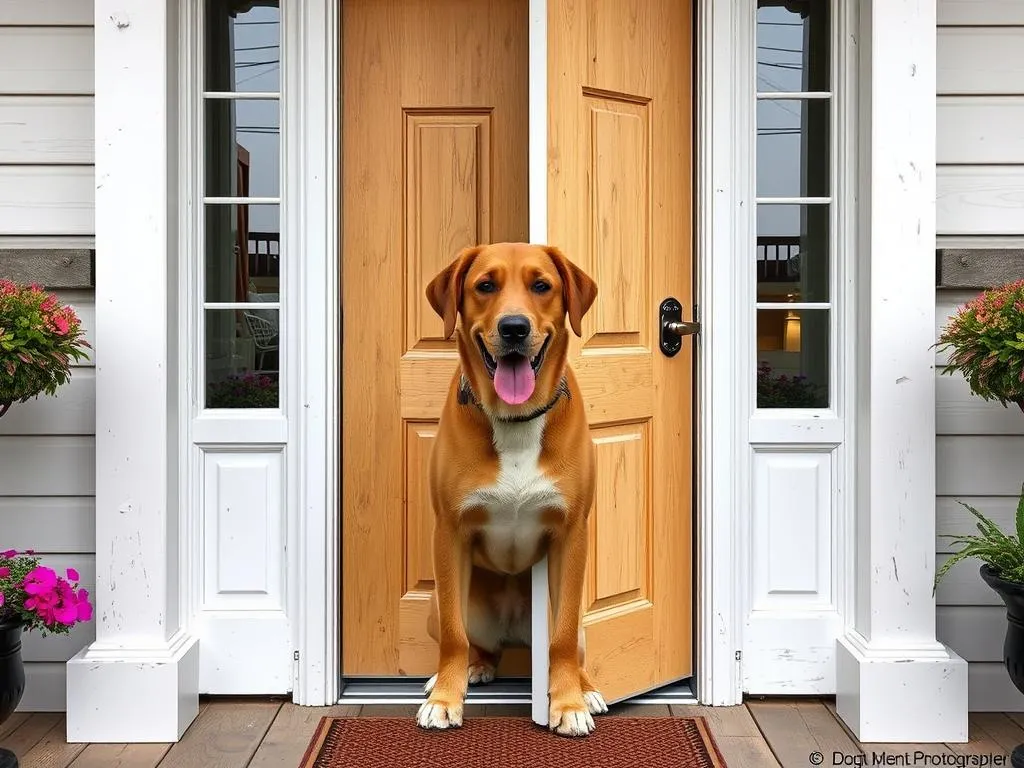
Creating a DIY dog door can be an empowering project for any pet owner. These handy installations offer your furry friends the freedom to come and go as they please, reducing the stress of waiting for you to open the door. A well-crafted dog door not only enhances your pet’s quality of life but can also improve your home’s functionality.
Benefits of DIY Dog Doors
Cost-Effectiveness
Building your own dog door can save you a significant amount of money. Pre-made options often come with a hefty price tag, especially when you consider installation costs. By opting for a DIY approach, you can source materials at a lower price and avoid labor costs entirely.
Customization
One of the most significant advantages of a DIY dog door is the ability to customize it to your pet’s needs. You can tailor the size, design, and materials to fit both your pet and your home’s aesthetics. Whether you have a small Chihuahua or a large Labrador, you’ll have the flexibility to create an entrance that suits your furry friend perfectly. You can also choose from various types of doors, such as sliding or hinged options, making it easy to match your existing decor.
Quality Control
When you take on the project yourself, you have complete control over the quality of materials used. This means you can select durable woods and reliable hardware to ensure your dog door stands the test of time. Your personal involvement in the building process can provide an extra layer of assurance that the door will be well-constructed and safe for your pet.
Considerations Before Starting
Assessing Your Home
Before diving into your DIY dog door project, take a moment to assess your home. Evaluate which door type and location would work best for installation. Consider factors like your home’s layout and flow. A door that opens directly into a busy hallway might not be ideal, whereas one leading to a backyard could be more suitable.
Pet Size and Behavior
Choosing the right size door is crucial. Measure your dog’s height and width to ensure they can easily fit through the door. Additionally, consider your pet’s behavior. If your dog is prone to escaping or you live in a high-crime area, you’ll need to think about security features, such as locks or flaps that prevent unauthorized entry.
Materials Needed
Gathering the right materials is essential for a successful DIY dog door project. Here’s a list of what you’ll generally need:
- Wood: For the frame and door.
- Hinges: To attach the door securely.
- Framing tools: Such as a saw, drill, and measuring tape.
- Flap material: Options include plastic or fabric, depending on your preference.
Having the right tools on hand will streamline the process and minimize delays.
Step-by-Step Guide to Building a DIY Dog Door
Planning Your Dog Door
Start by measuring your dog to determine the appropriate size of the door. As a general rule, the door height should be about 2 inches taller than your dog’s shoulder height, and the width should allow for easy passage. After measuring, sketch a design that outlines the dimensions and layout of your door.
Gathering Materials
Once you have your plan, gather all necessary materials. Visit your local hardware store or browse online for supplies. Look for high-quality wood and durable hinges. If you want to enhance your dog door, consider optional upgrades like weather flaps or locks for added security.
Preparing the Installation Site
Before beginning construction, prepare your installation site. If you’re replacing an existing door, carefully remove it and ensure the opening is clean and smooth. If you’re cutting a new opening, use a saw to create a clean cut, taking care to avoid any electrical wiring or plumbing that might be hidden behind the wall.
Constructing the Door Frame
Start building the frame for your DIY dog door. Use sturdy wood to create a rectangular frame that matches the dimensions you’ve determined. Cut the wood pieces to size, then assemble them using nails or screws. Ensure that the frame is sturdy and level, as this will significantly impact the door’s functionality.
Installing the Door Flap
Choose the right flap material based on your climate and your dog’s behavior. For example, a flexible plastic flap may work well in warmer climates, while a heavier fabric flap might be better for colder regions. Install the flap by attaching it securely to the top of the frame using hinges. Make sure it swings freely but can still create a seal when closed.
Final Adjustments and Testing
After installation, make the final adjustments to ensure the door is properly sealed and insulated. Check for gaps that could let in drafts. Test the door with your pet to ensure it opens and closes smoothly and that your dog can navigate through it without difficulty.
Additional Features and Options
Security Measures
Adding security features to your DIY dog door can enhance safety for both your pets and your home. Consider installing a lock or a secure closure that prevents unauthorized entry. Some dog doors come with magnetic or electronic locks that only open for your pet, adding an extra layer of security.
Weatherproofing
To ensure your dog door is resistant to the elements, consider weatherproofing options. Insulation strips can help seal gaps, preventing drafts and keeping your home comfortable. Choose durable materials that can withstand harsh weather, such as treated wood or metal.
Smart Dog Doors
For tech-savvy pet owners, incorporating smart technology into your DIY dog door can provide additional convenience. Automated or app-controlled options allow you to control your dog’s access remotely. While these options can be more expensive, they come with benefits like timer settings and alerts when your dog goes in or out.
Common Mistakes to Avoid
Incorrect Sizing
One of the most common mistakes when building a DIY dog door is incorrect sizing. Always ensure that you measure your pet accurately to accommodate their current size and any potential growth. A door that is too small can lead to frustration for your pet, while one that is too large could compromise home security.
Neglecting Safety
Safety should always be a priority. Avoid sharp edges that could harm your pet, and choose non-toxic materials. Ensure that the door does not create a security risk by allowing unwanted animals or intruders to enter your home.
Poor Planning
Many DIY projects fall short due to a lack of planning. Take the time to create a comprehensive plan before you start. This includes gathering all materials, outlining each step, and setting a realistic timeline for completion. Having a clear plan in place will help you stay organized and focused during the project.
Maintenance Tips for DIY Dog Doors
Regular Inspections
To prolong the life of your dog door, conduct regular inspections. Check for wear and tear, and look for signs that the door needs repairs or replacement. Pay attention to the flap, hinges, and seals, as these components often require maintenance.
Cleaning and Upkeep
Keeping your DIY dog door clean is essential for maintaining functionality. Use mild cleaning agents and a soft cloth to wipe down surfaces. Regularly check for dirt or debris that could interfere with the door’s operation. If your door has a flap, ensure it stays clean to avoid any odors or buildup.
Conclusion
Creating a DIY dog door can be a rewarding project that enhances your pet’s life and your home’s functionality. From cost savings to customization, the benefits are numerous. By following the steps outlined above, you can craft a durable and stylish dog door that meets your needs and those of your furry companion.
Taking on this project not only allows you to create something unique but also gives you the satisfaction of knowing you’ve improved your pet’s quality of life. So grab your tools and get started on your DIY dog door journey!









